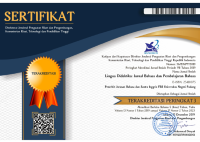Measuring Students’ Ability in Using Collocations in Argumentative Writing Across Gender
 ),
), (1) Universitas Negeri Malang
 Corresponding Author
Corresponding Author
Copyright (c) 2022 Lingua Didaktika: Jurnal Bahasa dan Pembelajaran Bahasa
DOI : https://doi.org/10.24036/ld.v16i1.116651
Full Text:
 Language : en
Language : en
Abstract
This research is a descriptive study. It investigates the difference of EFL male and female students’ ability in using collocations in argumentative writing. There were 24 students taking a writing test in this research. They were 17 female and 7 male students. The test used a writing test with two different writing prompts to be chosen by the students. The rubric focused on the use of collocationsas other elements of writing are ignored to make the test valid. The research findings show that overall score of the students’ ability in using collocations in argumentative writing is 63.8 which is in average level. There is no student with excellent ability, 13 students with good ability, 7 students with average ability, 3 students with fair ability and 1 student with poor ability. Another finding, even with different score 64.2 for male and 62.7 for female, there is no difference between the male and female students’ ability in collocations in argumentative writing as they both are in average level. In conlusion, the ability in using collocations of male and female students is in the same level.
Keywords
References
Brown, D.H & Abeywickrama. (2010). Language Assessment: Principles and Classroom Practices. USA: Longman.
Ganji, M. (2012). On the effect of gender and years of instruction on Iranian EFL Learners’ Collocational competence. English Language Teaching, 5(2), 123–133. https://doi.org/10.5539/elt.v5n2p123
Harida, E. S., & Hamka. (2019). Collocations mastery of the university students. Journal of English Linguistics, Literature and Education, 1(2), 201–208.
Kweldju, S. (1999) English Department Students’ Collocation Abilities. TEFLIN Journal, Volume X Number 1, August 1999
McCarthy, M. & Felicity, O. 2008. English Collocations in Use. Cambridge: Cambridge University Presss.
………………………………... 2017. English Collocations in Use Intermediate. Cambridge: Cambridge University Presss.
Nopita, D. (2021). EFL College Students’ Skill in Using Collocations in Writing Essays. Journal of Language, Literature, and English Teaching (JULIET), 2(1), 6–11. https://doi.org/10.31629/jjumrah.v2i1.3133
Petkovska, V & Silvana, N. 2020. The Importance of Collocations in Acquiring English as A. (N.D.). 15–27.
Thornburny, S. (2002). How to teach vocabulary. Malaysia: Longman
Wiyanto, M. S., & Asmorobangun, P. W. (2020). Gender Differences of Students’ Writing Ability in Descriptive Text. Journal of Languages and Language Teaching, 8(2), 153. https://doi.org/10.33394/jollt.v8i2.2314
Wulandari, S., & Trisno, E. (2020). A Study On Witing Ability Differences Between Male And Female Students in Describing People. Journal Of English Laguage Teaching, 9(4), 5. https://doi.org/10.24036/jelt.v9i4.110598
Xu, D., Akhter, S., & Hussain, A. (2020). Towards the importance of English collocations for L2 Learners , A Corpus-Based study. Revista Argentina de Clínica Psicológica, XXIX(N°3), 185–191. https://doi.org/10.24205/03276716.2020.712
Yalmiadi. (2016). Student ’ S Ability in Using Lexical Collocations in Descriptive Writing At the English Department. Jurnal Arbitrer, Vol. 3, No. 1, Edisi April 2016. https://www.freecollocation.com/
 Article Metrics
Article Metrics
 Abstract Views : 216 times
Abstract Views : 216 times
 PDF Downloaded : 83 times
PDF Downloaded : 83 times
Refbacks
- There are currently no refbacks.
Copyright (c) 2022 Lingua Didaktika: Jurnal Bahasa dan Pembelajaran Bahasa

This work is licensed under a Creative Commons Attribution-NonCommercial 4.0 International License.









